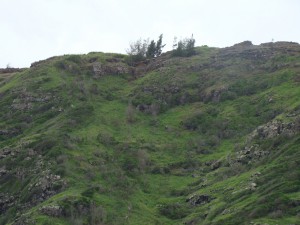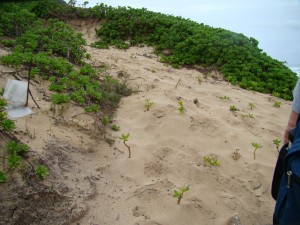Today we hiked to Kaena Point, the sight of the only Laysan albatross colony on Oahu. We also were on the lookout for Hawaiian monk seals, whales, and lots of native plant life.
Many refer to Kaena Point as the last natural place to be found on Oahu. This statement is not completely true. A better way to phrase it would be the last restored to nature place on Oahu.

At one point in time this beautiful reserve was overrun with non-native plants and very few native plants could be found. Today, as we moved further into the reserve we began to see more native Hawaiian vegetation.
Kaena Point is not only a nature reserve but it is also an important cultural landmark. In the Hawaiian culture it is believed that when you die your soul leaves the island through a soul rock and each island has a specific place where the rock is located. The one for Oahu is located with the reserve. There are also traditional burial sites within the reserve.
Our day started early with a quick trip to the coffee shop to grab some tasty breakfast morsels before heading off to Kaena Point. Once we arrived we meet our guides for the day: Dr. Lindsay Young (UH) & Tracy Wurth (NMFS) as well as David and Shannon from HPU. The round trip hike was about 6 miles so we were in for a long day. The nature reserve is open to the public and there are some “roads” that people are able to drive up to reach different areas of the reserve. Along the way, Lindsay talked to us about the historical importance of the area to native Hawaiians and that some of the boulders on the beach were used as torch markers to show canoes where to come ashore. After walking for awhile we reached the entrance to the reserve that has a large gate to keep cars from entering.

The next leg of our hike took us into the reserve. One of the first things you notice are the signs saying no pets allowed and watch for leg traps. The reserve has issues with introduced mammals such as cats, mice, and mongoose. These each pose a threat to the birds nesting in the reserve. The newest way the reserve is combating this is to use a predator fence. This fence will keep out mammalian predators that would attempt to enter the reserve by climbing, jumping, or burrowing. The fence has a fine mesh type structure that is buried into the ground as well as an attached cover. At this time, the fence is 90% complete and will have pedestrian access gates similar to an aviary. The location of the fence itself was difficult to determine due to the historic nature of the area and local Hawaiian communities did have an input on where the fence went.

As we continued to hike the first sounds of albatross could be heard. Before I continue, a little side note: I am obsessed with penguins and seabirds and most people who know me would say the word obsessed doesn’t even cover it. So hearing, much less seeing an albatross was incredibly exciting.
We spotted our first nesting albatross not far into the reserve. Lindsay was the biologist with us that studies this colony of albatross. Each bird has two bands — one on each leg — that are used not only for individual identification but to identify what island they came from. We would be helping/watching Lindsay conduct nest surveys. Her goal was to read the band on each individual we saw and if they were on a nest how the egg was and which parent was on it. The interesting thing about this colony is that there are more females than males and you see female-female nests. Each female will lay an egg but only one will be kept and raised by the pair. This makes for a very unique natural situation for biologists to study. While walking with Lindsay one thing we were checking was for any unbanded birds or birds with transmitters. Lucky for us we found one of each! Two of us got to help by holding the bird while the bands were placed or the transmitter was removed. Now remember the obsessed seabird comment and you can guess how excited I was. This colony was only the tip of the iceberg compared to the colonies that exist on Midway.

Albatross weren’t the only animal on our minds for the day. We very lucky in that Tracy was able to find two Hawaiian monk seals basking on the beach. These seals are endemic to the Hawaiian islands and endangered. There are colonies throughout the Northwest Hawaiian Islands and on Oahu. The seals on Oahu are faced with many issues involving interactions with humans. Though they are protected under U.S. law, there are no enforceable guidelines on how close you can get to them. Tracy explained to the group how she identifies the seals. She was able to clearly identify one, Sharkbait, but she was not sure of the second one so took pictures to compare to photo id records. Finally, as with any day in Hawaii in January, we saw humpback whales. There was a mother and calf pair that was breaching right off of the point.

After the long hike back we were all ready for some lunch before heading back for the evening which, for some I know, involved more Yogurtland. Mine involved getting my lost luggage — at long last.

Yikes! Albatross banding could be hazardous to your health! Those big guys look like they could do some damage if not properly constrained.
Hayden liked it when you were holding the bird. He had on his TV face, very intent
Very cool…love the video!
How many nesting pairs are there now?
Hey Tom:
About 60 pairs and 150 birds total, as I recall. Immigrants, mostly female, are still arriving from elsewhere. We also saw several birds with yellow bands, that had been successfully translocated from air strips, where they pose an obvious hazard.
LOVED the video. So wonderful to see some work being done to save our planet.
It looks like you guys had a fantastic day out there! I’m stoked that you guys got to see the fence as it is being built – that has been a long time coming and represents an important conservation milestone for Kaena Pt.and Hawaii in general!
Wish I could be there with y’all – can’t wait to read about what happens next!